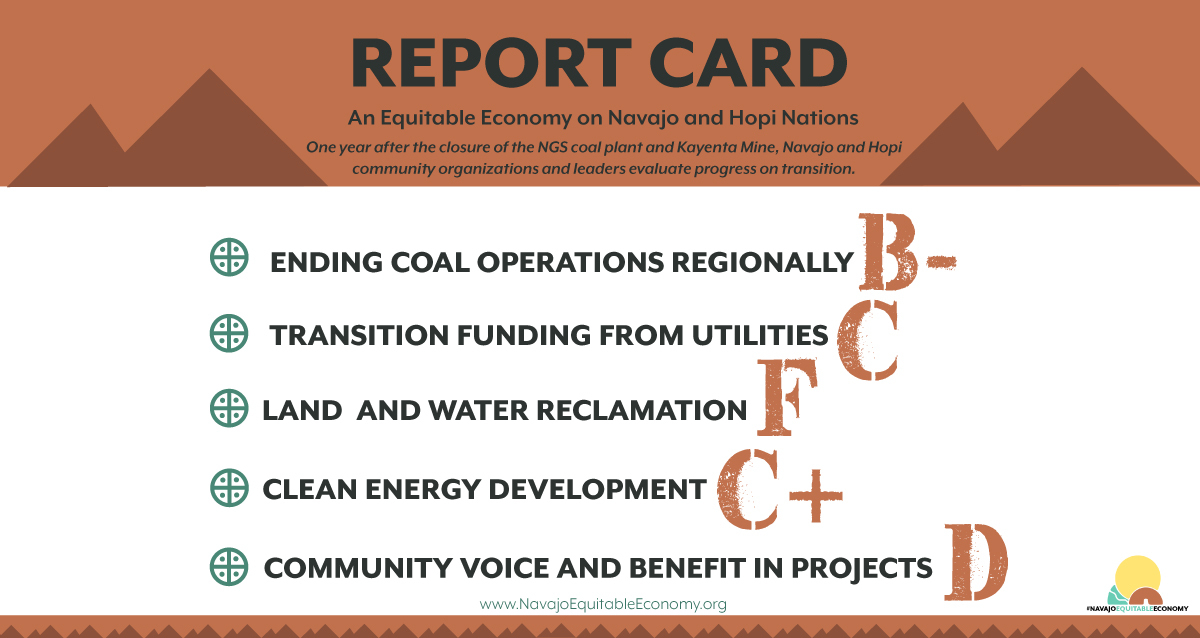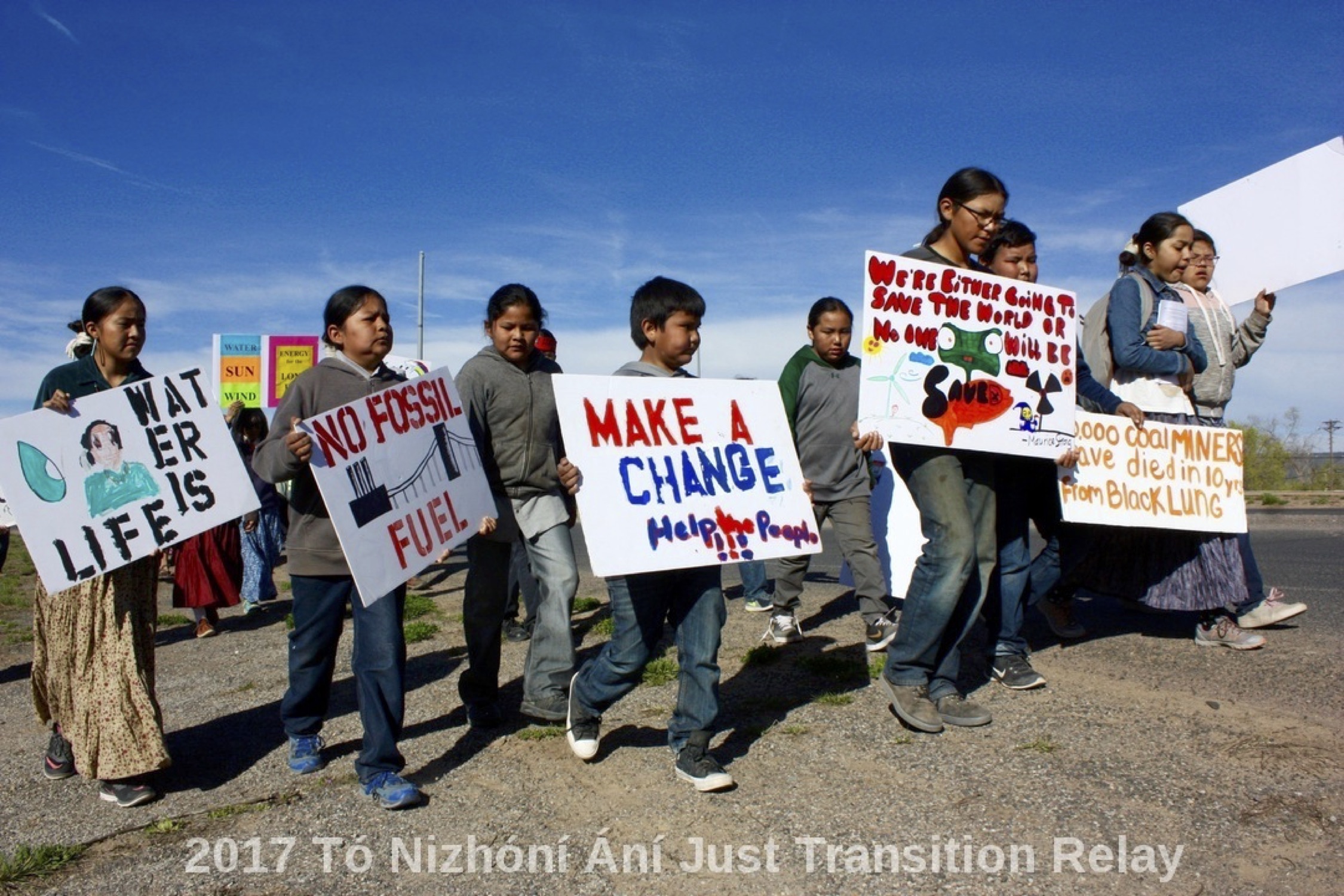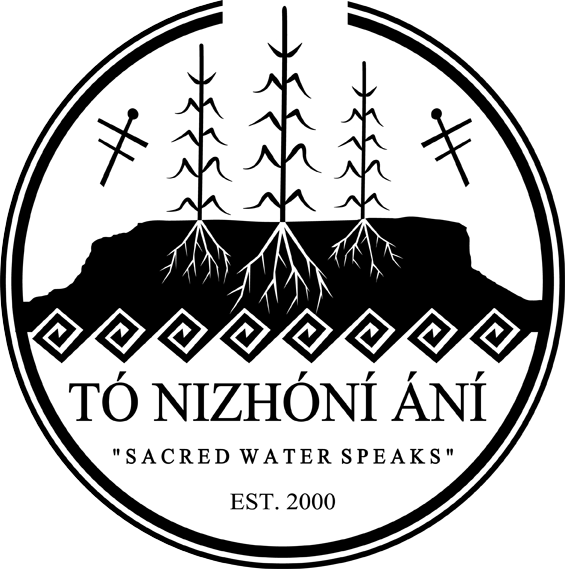A path for our economic future,
rooted in traditional DINÉ VALUES.
As coal markets end, we have an historic opportunity to create a sustainable economy and future.
REPORT CARD
A year after NGS closure...
Measuring progress toward an equitable economy on Navajo and Hopi Nations
When the Navajo Generating Station burned the last of its coal on November 18th, 2019, the Navajo Equitable Economy Initiative launched to present a vision for building an economy rooted in Diné Fundamental Law and traditional values that honor the natural world. We also vowed to track progress on transition and clean-up efforts. One year later, Navajo and Hopi community groups and community leaders have seen progress in some areas, but inaction in others.
The equitable economy vision calls for progres in several areas, including ending extraction and burning of coal; developing projects like clean energy that are in harmony with sacred tribal values; corporate accountability for transition assistance funding and restoration of damaged land and water; and ensuring that community benefits and voices are centered in economic development.
Now, at the one-year anniversary of the closure of NGS, it is time to take stock. How are utility and government officials doing? Where has progress been made? What problems remain and where is action needed?
Here are the details on the five areas we have been tracking:
1. Ending coal operations regionally
Letter grade:
B-
What progress have we seen?
- NGS burned the last of its coal in 2019.
- The San Juan Generating Station is set to close by the end of 2022.
- The Cholla Power Plant is set to close by 2025.
- Navajo Nation President Nez issued the Navajo Háyoołkááł (Sunrise) Proclamation.
What problems need to be addressed? Where is action needed?
- APS still plans to burn coal at the Four Corners Power Plant for another decade.
- NTEC plans to expand its ownership in the Four Corners Power Plant.
- NTEC acquired money-losing coal mines in Wyoming and Montana.

2. Transition funding from utilities
Letter grade:
C
What progress have we seen?
- APS committed $144 million to Navajo Nation and Hopi Tribe, and other affected communities for post-coal economic transition
- The ACC required APS to implement energy efficiency program projects with Navajo and Hopi tribal communities
- Under an ACC decision on APS Integrated Resource Planning (IRP), the company will need to give preference to coal-impacted communities for siting replacement power.
- The Navajo Nation intervened in APS proceedings on Four Corners Power Plant to push for transition assistance, and the ACC ruled that the company must plan for it.
- Passage of the Energy Transition Act in New Mexico
- Hopi Tribe has intervened in the TEP rates case to press the utility for transition assistance.
What problems need to be addressed? Where is action needed?
- No transition assistance funding from the closure of NGS committed yet by SRP, TEP, CAP, DOI, NV Energy, or LADWP
- APS transition package needs ACC approval.

3. Land and water reclamation
Letter grade:
F
What progress have we seen?
- Letter from Congressman Grijalva to OSMRE, requesting a significant permit revision for Kayenta Mine and taking note of the appalling lack of cleanup.
- Letter from former Hopi Tribal Chairmen to OSMRE and their voices in the media calling on officials to ensure proper reclamation of mines.
- The APS transition package includes support from the utility for the Navajo Nation’s efforts to acquire water rights associated with the Four Corners Power Plant.
What problems need to be addressed? Where is action needed?
- Very little action from tribal leaders to demand accountability
- No reclamation by Peabody at Kayenta Mine of either land or N-Aquifer water damaged by decades of mining.
- Dismissive responses by OSM to efforts by community groups asking for action on reclamation.
- The 34,000 acre-feet of water from NGS, whose rights should belong to the Navajo, are still not allocated.
- In failing to meet its responsibilities, Peabody Energy is costing the Navajo and Hopi hundreds of jobs that could be deployed in the clean up and reclamation of Kayeta Mine.
- Delays in getting a contract with the United Mining Workers for reclamation work
- Lack of access to water availability during the pandemic.

4. Clean energy development
Letter grade:
C+
What progress have we seen?
- LADWP will partner with the Navajo Nation on clean energy projects.
- SRP has issued a Request For Proposals (RFP), with two bids in, from Navajo Power and NTEC.
What problems need to be addressed? Where is action needed?
- Currently there is still no framework in place for a utility-tribal partnership with LADWP-Navajo Nation.
- Project pipeline overall is small (just two in response to the SRP RFP), relative to the vast scale of renewable resources and transmission available and the need for a faster pace to seize the window of opportunity.

5. Community voice and benefit in projects
Letter grade:
D
What progress have we seen?
- Some Navajo Nation local chapters have been considering local goals for clean energy and granting pre-approval for projects.
- The APS just transition package includes cost-free electrification for some homes on the Navajo Nation that currently lack electricity.
What problems need to be addressed? Where is action needed?
- NTEC has moved forward projects -- such as its purchases of Montana and Wyoming mines -- that have shut out community voices and are in conflict with Diné Fundamental Law, and circumvent the authority of the Navajo government.

Please share the report card with your networks and friends! Right click to save the image for sharing.





